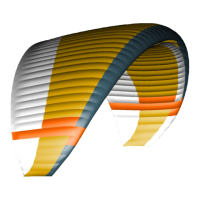_63 _EN_62
Stalls
Spin
If the pilot brakes one side of the glider too much, a spin will result.
In a conventional turn, the axis of rotation is remote from the wing.
When a wing spins, the axis of rotation moves within the wing span.
The over-braked side of the wing slides back.
The correct pilot reaction is to immediately release both brakes. Occa-
sionally it is necessary to stop the canopy pitching forward.
Full stall
If both brakes are symmetrically pulled too far, a full stall will result. This
means that the wing loses its forward momentum, whilst the pilot con
-
tinues to travel forwards. From the pilot’s perspective it feels like the
wing falls backwards. At this moment it is essential that the brakes are
not fully released as there is a risk that the wing will dive – potentially
underneath the pilot.
The available brake travel up to the stall point depends on the size of
the wing:
• 61 cm
for the
AONIC XXS • 63 cm
for the
AONIC XS
• 66 cm
for the
AONIC S • 71 cm
for the
AONIC M
• 74 cm
for the
AONIC L
These figures give a rough indication. Their inclusion in this manual is
required by EN 926. In turbulent air, a stall may occur markedly sooner
or later than these figures indicate. Therefore these figures only have
limited significance.
Collapses
Asymmetric collapses
When flying into strong turbulence, one side of the paraglider may
collapse. This happens because the turbulence causes the angle
of attack on that side to decrease to the extent that lift is no longer
generated, the lines de-pressure and the wing collapses.
Such a collapse normally only affects a small part of the whole span
and the wing will not react significantly. During larger collapses which
affect 50 percent or more of the span, the wing will clearly react: due
to the increased drag of the collapsed side, the glider will begin to turn
towards that side. Simultaneously the wing will pitch forward because
of the reduced area carrying the wing loading, i.e. because this causes
that side of the wing to accelerate.
The pilot can prevent this turn and forward pitch by braking the un-
collapsed side of the wing. Braking the uncollapsed side is essential,
especially near the ground. This manoeuvre should be practised with
induced collapsed at height, preferably during an SIV/pilotage course.
Frontal collapse
A frontal collapse is also a consequence of turbulence. Unlike an
asymmetric collapse, during a frontal collapse the whole leading edge
folds downwards.
All our paragliders open automatically after frontal, as well as asym-
metric collapses (as stipulated in the certification standards). To speed
up the re-inflation of the leading edge after a frontal collapse, we
recommend a very short stab of both brakes. It is important to then
release both brakes completely.
If the open side is
braked too much the
glider may spin – see
the section on spins.
!
A full stall is a
complex manoeuvre
and an explanation of
its correct execution
is beyond the scope
of this manual.
Anyone wishing to
learn this manoeuvre
should undertake an
SIV/pilotage course.
!

